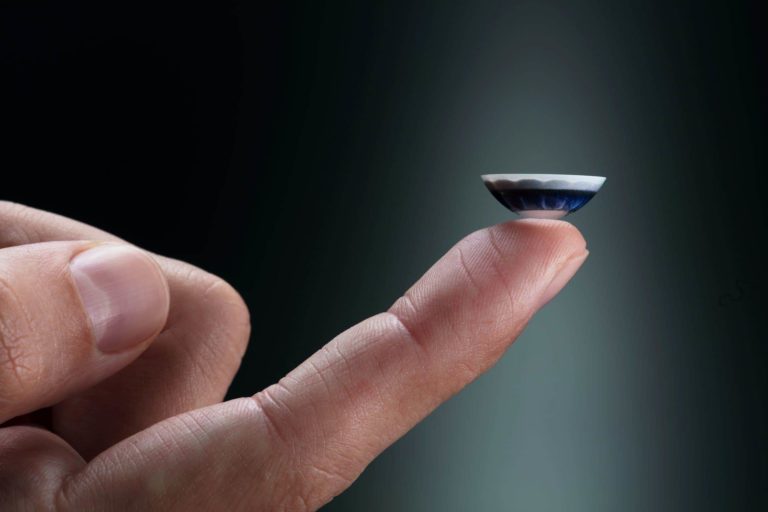
It’s no secret that technology has the power to change the way we live for the better. For those with poor eyesight, the future of eyeglasses and contact lenses may be changed, as more companies are developing contact lenses integrated with augmented reality (AR) technology.
People will sport eyewear for various reasons — some reasons are to correct nearsightedness or treat astigmatism, while others may wear fake glasses as a fashion statement.
According to the Centers for Disease Control and Prevention (CDC), around 45 million people in the U.S. wear contact lenses. It’s challenging to determine the exact number of people who have some eye complication or vision impairment. Some people decide not to use glasses or contacts to correct problems with their eyes.
So, what are AR contact lenses, what recent developments have been made in this space, and what can we expect to see in the future? Let’s explore some of these questions and dive into the uses of AR contact lenses as well.
What Are AR Contact Lenses?
Soon to be a part of daily life, smart contact lenses integrated with AR are being developed by a handful of companies.
The lenses would allow users to see information about their surroundings directly in their line of sight rather than use AR glasses. Some popular smart glasses have emerged in the past decade. For example, Google Glass, Vuzix Blade, and Ray-Ban Stories are examples of smart glasses that people have used to improve their vision and get the most out of their eyewear.
AR contact lenses have the potential to not only correct vision problems but also give users a smart experience by displaying digital content right there in front of them.
Applications for AR Contact Lenses
While contacts integrated with AR are still under development, there are many ways they can be used to help those with eyesight problems.
First and foremost, AR contacts can provide you with enhanced visuals, real-time contrast and lighting adjustments, and even night vision. These lenses may also have a zoom feature, which can be helpful in many cases.
While there are many applications on the consumer end, there are also plenty of ways industries can use them to increase their operational efficiency. For example, lenses that zoom in on far-away objects for measurement purposes may be helpful in construction or electric work and keep workers in these fields from having to spend hundreds of dollars on equipment to get closer to the objects.
Another example is firefighters using AR contact lenses to navigate their surroundings while in a smoky building. Smoke can make it hard to locate victims, but these lenses could serve as a viable solution when saving lives.
AR lenses also have a variety of applications in the health and medical industries. For instance, surgeons or medical students could see data about a patient’s condition without relying on other wearables or devices away from the operating table. These are only some examples, but more will emerge as technology advances.
Companies in the AR Contact Lens Market
There are a handful of AR startups looking into creating these advanced, more intuitive contact lenses. The three companies we’ll highlight include InWith Corporation, Mojo Vision, and Apple.
1. InWith Corp.
InWith Corp. announced new technology that can change contact lenses at the 2021 Consumer Electronics Show (CES). The technology will enable developers to place AR chips in soft contact lenses to improve the vision of everyday consumers.
InWith is one of the only companies to go public with this technology, as other companies in the space have primarily worked on harder, less comfortable “scleral” lenses.
2. Mojo Vision
Mojo Vision recently announced the progress it’s made in embedding tiny AR displays into contact lenses. Here’s what their preliminary technology looks like:
- Lenses full of electronics, including a camera that captures the environment
- A computer chip that processes imagery, controls the display, and communicates with external devices like smartphones
- Embedded motion tracker that tracks eye movements
- The device is battery-powered and can be charged overnight
3. Apple
Apple hopes to release AR contact lenses by the end of the decade, according to reliable Apple analyst Ming-Chi Kuo. The ultimate goal for any company in this sector is to turn visible computing into invisible computing by creating lenses capable of accomplishing more than your average contact lens.
Kuo says the lenses will likely work in tandem with the iPhone but will not have independent storage for computing. Apple may change these plans based on how the technology advances.
It’s interesting to see which companies have plans to bring AR contacts to the market. Consumers everywhere could benefit from this tech within the next few decades. However, what kind of obstacles will these companies need to overcome before launching these innovations?
Potential Setbacks in Development
One of the more challenging aspects of developing this tech is bridging the gap between the eyes, the hardware, and the brain. Understanding how the brain processes information taken in from the eyes will be critical in creating lenses with this level of functionality.
Aside from overcoming the technical challenges of these lenses, it’ll also require companies to be medically approved so consumers can reap the benefits they have to offer.
Traditional contact lenses are considered medical devices and must be approved by the FDA, and it’s likely that AR lenses will also be subject to approval. Mojo Vision has yet to test its product out on the market, as only company employees have tested them so far.
Mojo Vision has been researching and developing its prototypes for some time now, and they’re still not ready to launch.
With any new technology comes potential setbacks. Because it’s taken years of R&D until this point, it may still be a while before AR contact lenses are available to the general public.
The Future of Vision: Driven by AR
Having contact lenses is crucial for some people, but traditional lenses may become obsolete with new technology like AR. It’ll be interesting to see how the leading companies in the space work to develop AR contact lenses to improve people’s lives worldwide.
Aside from just consumer applications, these lenses could provide even more benefits for employees in various industries. Keep an eye out in the future for AR contact lenses.
 April Miller is a senior writer at ReHack Magazine and editorial contributor at AR Insider. She specializes in VR/AR, IoT, and business technology. See her work here and follow her @rehackmagazine.
April Miller is a senior writer at ReHack Magazine and editorial contributor at AR Insider. She specializes in VR/AR, IoT, and business technology. See her work here and follow her @rehackmagazine.

